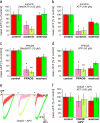Purinergic receptor-mediated Ca signaling in the olfactory bulb and the neurogenic area of the lateral ventricles
- PMID: 21437013
- PMCID: PMC3033506
- DOI: 10.1007/s11302-010-9207-6
Purinergic receptor-mediated Ca signaling in the olfactory bulb and the neurogenic area of the lateral ventricles
Abstract
Like in other vertebrates, the anterior part of the telencephalon of amphibians mainly consists of the olfactory bulb (OB), but different from higher vertebrates, the lateral telencephalic ventricles of larval Xenopus laevis expand deep into the anterior telencephalon. The neurogenic periventricular zone (PVZ) of the lateral ventricles generates new OB neurons throughout the animal's lifetime. We investigated the ultrastructural organization of the PVZ and found that within a time period of 24 h, 42.54 ± 6.65% of all PVZ cells were actively proliferating. Functional purinergic receptors are widespread in the central nervous system and their activation has been associated with many critical physiological processes, including the regulation of cell proliferation. In the present study we identified and characterized the purinergic system of the OB and the PVZ. ATP and 2MeSATP induced strong [Ca(2+)](i) increases in cells of both regions, which could be attenuated by purinergic antagonists. However, a more thorough pharmacological investigation revealed clear differences between the two brain regions. Cells of the OB almost exclusively express ionotropic P2X purinergic receptor subtypes, whereas PVZ cells express both ionotropic P2X and metabotropic P1 and P2Y receptor subtypes. The P2X receptors expressed in the OB are evidently not involved in the immediate processing of olfactory information.
Keywords: Neuronal stem cells; Olfaction; P1 receptors; P2 receptors; Subventricular zone.
Figures








Similar articles
-
Pharmacological properties of purinergic receptors and their effects on proliferation and induction of neuronal differentiation of P19 embryonal carcinoma cells.Int J Dev Neurosci. 2008 Nov;26(7):763-77. doi: 10.1016/j.ijdevneu.2008.07.008. Epub 2008 Jul 18. Int J Dev Neurosci. 2008. PMID: 18675894
-
Purinergic signaling negatively regulates activity of an olfactory receptor in an odorant-dependent manner.Neuroscience. 2014 Sep 5;275:89-101. doi: 10.1016/j.neuroscience.2014.05.055. Epub 2014 Jun 10. Neuroscience. 2014. PMID: 24928349
-
Dynamic expression of the pro-dopaminergic transcription factors Pax6 and Dlx2 during postnatal olfactory bulb neurogenesis.Front Cell Neurosci. 2012 Feb 27;6:6. doi: 10.3389/fncel.2012.00006. eCollection 2012 Jan 5. Front Cell Neurosci. 2012. PMID: 22371698 Free PMC article.
-
P2Y and P2X purinoceptor mediated Ca2+ signalling in glial cell pathology in the central nervous system.Eur J Pharmacol. 2002 Jul 5;447(2-3):247-60. doi: 10.1016/s0014-2999(02)01756-9. Eur J Pharmacol. 2002. PMID: 12151016 Review.
-
Purinergic receptors in embryonic and adult neurogenesis.Neuropharmacology. 2016 May;104:272-81. doi: 10.1016/j.neuropharm.2015.10.008. Epub 2015 Oct 9. Neuropharmacology. 2016. PMID: 26456352 Review.
Cited by
-
The role of purinergic signaling in acupuncture-mediated relief of neuropathic and inflammatory pain.Purinergic Signal. 2024 Feb 2. doi: 10.1007/s11302-024-09985-y. Online ahead of print. Purinergic Signal. 2024. PMID: 38305986 Review.
-
P2Y1 receptor activation by photolysis of caged ATP enhances neuronal network activity in the developing olfactory bulb.Purinergic Signal. 2012 Jun;8(2):191-8. doi: 10.1007/s11302-011-9286-z. Epub 2011 Dec 22. Purinergic Signal. 2012. PMID: 22187118 Free PMC article.
-
Purinergic receptor-induced Ca2+ signaling in the neuroepithelium of the vomeronasal organ of larval Xenopus laevis.Purinergic Signal. 2014;10(2):327-36. doi: 10.1007/s11302-013-9402-3. Epub 2013 Nov 23. Purinergic Signal. 2014. PMID: 24271060 Free PMC article.
References
-
- Filoni S, Bernardini S, Cannata SM. Differences in the decrease in regenerative capacity of various brain regions of Xenopus laevis are related to differences in the undifferentiated cell populations. J Hirnforsch. 1995;36:523–529. - PubMed
LinkOut - more resources
Full Text Sources
Miscellaneous

